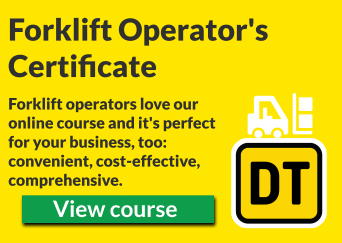Forklift vs pedestrian accidents usually don’t turn out well for the pedestrian. As the forklift is heavy, an accident where the pedestrian is run over is always serious and sometimes fatal as the weight simply crushes the pedestrian. The main causes of forklift accidents with pedestrians are:
- Inattention by the driver
- Pedestrian is obscured by the forklift’s load or something in the warehouse, e.g. around the corner of an aisle
- Pedestrian is walking in an area they shouldn’t be, e.g. directly behind an operating forklift or in areas that are prohibited for pedestrians to walk in a yard or warehouse
- Pedestrian is standing too close to an operating forklift and is hit by the load the forklift is carrying or is run over when the operator drives away
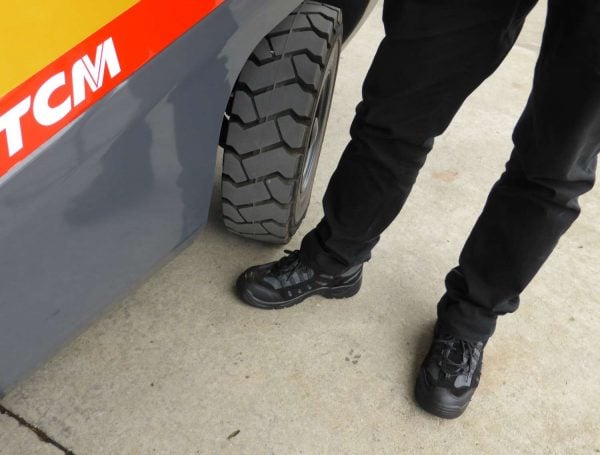
The operator is turning away from the pedestrian, but the rear swings towards the pedestrian and can run them over - Pedestrian is riding on the forklift and falls off
The optimal solution is to always have pedestrians separated from any forklift activity, but that’s not always possible. The following suggestions can be implemented in an area where forklifts are operating to help reduce the risk of incidents involving pedestrians.
Pedestrian visibility
All workers on foot working around forklifts should be wearing high-vis vests and boots with steel toecaps. Hard hats are optional and it depends on the workplace, but a hard hat makes the pedestrian taller and more visible as well as providing rudimentary protection against falling objects. A company should have a personal protective equipment policy outlining the minimum level of PPE.
Pedestrians should stick to designated walkways unless they are sure they have the attention of the forklift operator. They should also adhere to any ‘bloodlines’ or crossings – areas of the walkway they have to stop and look before proceeding forward, such as where a forklift might cross the walkway.
Forklift drivers should be aware of wearing glasses if they are moving between warm and cold areas due to the glasses steaming up
Forklift drivers should always travel in reverse if they are carrying a load which obscures their forward vision unless they are driving up a ramp, in which case another operator can be a spotter and guide them.
Truck drivers who are waiting for their truck to be unloaded or loaded should wait either in a safe area designated by the company, e.g. a reception area, or in sight of the forklift operator.
Pedestrian education and direction
A site board should be placed at the entrance to the site.
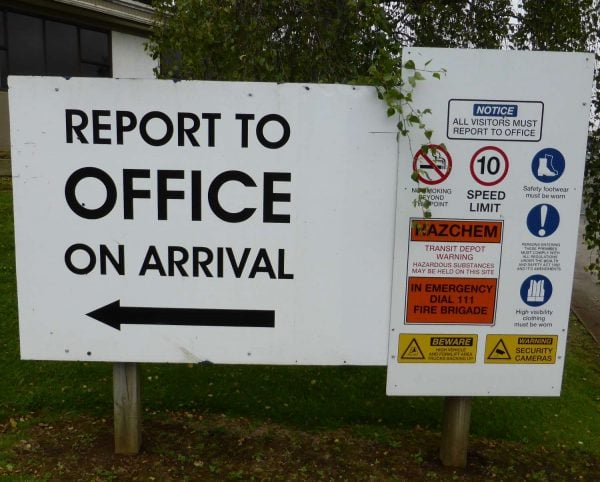
Visitors to the site should be made aware of forklift operations and where they occur and should be accompanied at all times by a representative of the company.
Employees should be trained in how to behave around forklifts before being allowed where they are operating. They need to understand the rear end swing as a forklift turns and must never walk under raised forks. Employees must be careful when working between goods that might be moved by a forklift.

All visitors and workers should understand that a loaded forklift takes some distance to stop and that braking suddenly could cause the load to fall off the forks.
Driver obligations
It’s best practice for forklift drivers to give way to pedestrians, to proceed with caution through a congested area and to know any hazards on an intended route. This is particularly important if a forklift driver has driven a truck to a client’s premises and is using their forklift to unload or load goods.
Drivers should signal to pedestrians if they need them to move out of the way, wait until they have moved, then drive through.
Traffic control signs, warehouse speed limits and convex mirrors on corners help drivers.
Drivers and pedestrians should never wear ear protection or be listening to music on headphones.
When a forklift is parked, the forks should be lowered to the floor, tips down, and the handbrake must be applied.
Drivers should slow down on the approach to crossing points (i.e. where they have to cross walkways).
If you are concerned that a driver may have to make an emergency stop in any place then you can mandate that the forklift only travels backwards through these areas, otherwise they would lose any load they are carrying.
Warning methods
In low-visibility situations, forklifts should use revolving or flashing warning lights and headlights. When driving through PVC strip curtain doors or around blind corners, an operator should sound the horn; pedestrians should ideally use a separate entrance or pathway to avoid conflicts with moving forklifts.
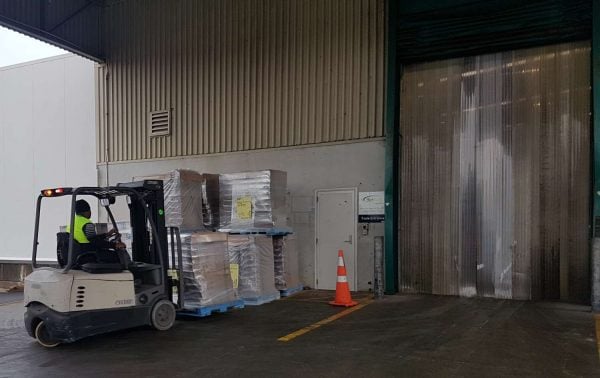
Forklifts should have a buzzer or beeper when operating in reverse.
Separation methods
Areas where pedestrians walk regularly should, at minimum, have painted markings to keep the pedestrians on them and to alert drivers that pedestrians walk there. Further separation can be achieved with cones or railings. Any areas with painted markings should be kept clear of obstacles so that pedestrians don’t have to step outside them.
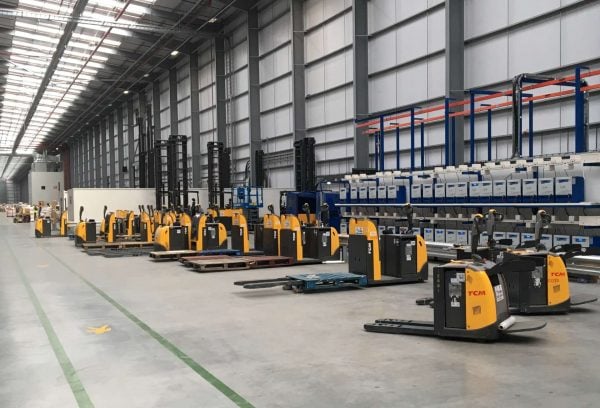
Pedestrians can be prohibited from certain areas during certain work times.
Responsibilities
Everyone in the warehouse is responsible for safety but pedestrians ultimately must have responsibility for their actions, assuming all hazard have been eliminated.
A supervisor should let drivers know if there will be additional or unusual pedestrian movements during a shift and let pedestrians know if there will be additional or unusual forklift activity during a shift.
Is there anything you can do in your warehouse to eliminate or reduce the need for pedestrians to interact with forklifts. For example, do people have to cross a warehouse or yard to reach toilet or kitchen facilities, and can these be moved? Can you reconfigure your warehouse or goods so that there is less interaction?
How should a pedestrian approach a forklift?
Eye contact should be made and either a hand signal or verbal command to instruct the forklift driver to approach, or for the forklift driver to stop while the pedestrian approaches.
The exclusion zone should be respected until the forklift is made safe – this is typically three metres. The forklift is made safe once the driver has lowered the forks to the floor, tips down, or to axle height if a load is being carried (unless it’s impractical), then put it in neutral and applied the handbrake. Some companies require their forklift to be turned off in this situation.
Once the conversation is done, the pedestrian should step back outside the exclusion zone to avoid being run over by the forklift.
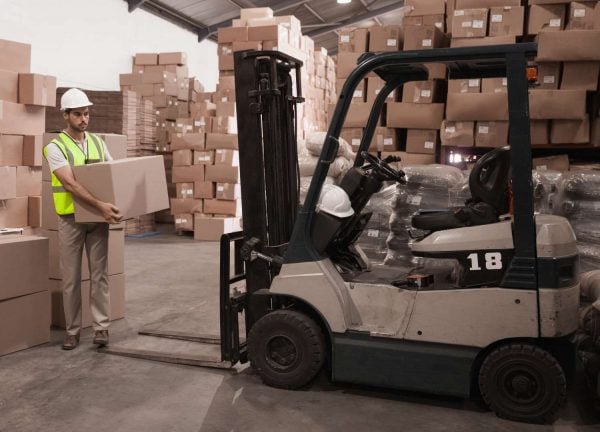
The three-metre exclusion zone works well for smaller forklifts, but for larger forklifts it’s best to pick an exclusion zone that is more than the radius of the turning circle of the forklift. A container handler may have a turning circle up to seven metres! An exclusion zone greater than the turning radius ensures that if the forklift pivots around its drive axis, pedestrians outside the exclusion zone should be safe.
Some companies set their exclusion zone to be the mast height at the maximum lift height of an item on their premises. For example, if the mast height is 5 metres at that point, if the forklift toppled over, it would hit someone standing 5 metres away, so the exclusion zone would be set above 5 metres.
Learning forklift safety as a driver
Forklift drivers must take a forklift course before they can drive. The course will outline health and safety information as well as forklift operation.

